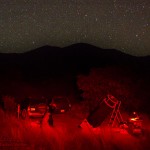As we are all aware, the TMT protests are having direct consequences for everyone who goes to the mountain. Regular mountain users and tourists alike are dealing these consequences. The summit road closed to the public for a second week, the MKVIS also closed, even before these closures the protests had curtailed many activities.

An agenda item that will appear before this week’s DLNR board meeting contains significant rule changes regarding use of the lands surrounding the Mauna Kea access road. For the local amateur astronomy community this looks to be very serious, a complete closure of a place we have all come to value very highly.
Go the the Mauna Kea Visitor Information Station on the weekends nearest new Moon and you will find telescopes. While the MKVIS telescopes get put away at 10pm there are ‘scopes that are operating late into the night, often still there when dawn colors the sky. These telescopes belong to local amateur astronomers who bring them here to enjoy perfect Mauna Kea skies.
The MKVIS is the best place to enjoy the night sky, and we have been welcomed in doing so. Personally I have lost count of the number of times I have spent the night beside a telescope in the MKVIS parking lot. Not just the MKVIS, which is under OMKM jurisdiction, but also nearby sites such as the substation and the R1 road parking lot. No hassle from DLNR, and generally a warm welcome from the Mauna Kea rangers.
Just this last week I had a nice conversation with the DOCARE Hilo supervisor over breakfast at Hale Pohaku. DOCARE is the enforcement department within DLNR, it is their law enforcement officers that deal with issues on DLNR lands. With such an opportunity I specifically asked the question, what is his view of using a telescope on DLNR administered land? We discussed the official definition of camping and he readily agreed that using DLNR land to observe was not camping and that local amateur astronomers are welcome to do so.

No sooner than that conversation takes place I have learned that the rules might change. The proposed rule changes can be seen on the DLNR website.
§13-123-21.2 Prohibited activities.
(a) The area covered by this rule is described as any lands within one mile of the Mauna Kea Observatory Access Road and referred to in this rule as the “restricted area.”
(b) No person shall at any time bring in to the restricted area or possess or control in the restricted area any of the following items: backpack, tents, blankets, tarpaulins, or other obvious camping paraphernalia.
(c) No person shall enter or remain in the restricted area during the hours of 8:00 p.m. to 5:00 a.m., except to the extent the person is transiting through the restricted area in a motor vehicle on the Mauna Kea Observatory Access Road.
These rule changes are troubling. If enforced as written they would prohibit amateur astronomers from using the VIS area for observing through the night as we have done for decades. These rules are notable more strict that the rules normally applied to DLNR administered lands. Under the normal rules possession of camping gear is only a violation if you are present during the hours of darkness, this has been changed to “any time”. The complete ban on using the area near the access road during hours of darkness, even without “camping” is completely new.
A strict reading would even prohibit the official evening observing program at the MKVIS, where the general public is invited to stay until closing at 10pm. I have addressed my concerns here to Stewart Hunter, the head of MKSS. He has seen the rules and the university will be testifying, I have no information as to what that testimony will include.
We could continue to use nearby lands, as long as the sites were more than one mile from the access road. This would require traversing a mile or more of rough road to reach a site far enough from the paved access road to satisfy the new rules.
Testimony on the proposed rule changes may be submitted in person, by email or standard mail. Addresses can be found on the DLNR website. I would note that protest groups have publicized these rule changes and are also likely to submit testimony.


I have never seen amateurs set up on the mountain. Normally the visitor center has their own telescopes set up. People do not belong on the mountain if they don’t care about it’s sacredness.
Most have stopped going since the protests began, the lights and disturbance from the protest have ruined the VIS area for observing. Before? Just about any weekend near new Moon would see several setup at or near the VIS. Look back through my blog for multiple posts on typical events.
The mountain is sacred, for everyone, even if not in quite the same sense. I do not belive in god or in goddesses, but see Mauna Kea as a place to reconnect with the universe.
It’s a shame that so many people have give up so much because of the loudness of a few
It will soon be mid July and a new moon. Where do I go now?